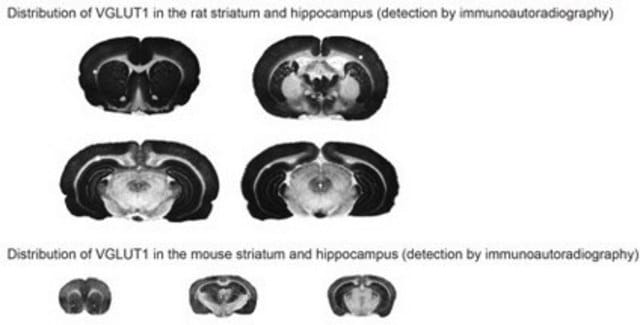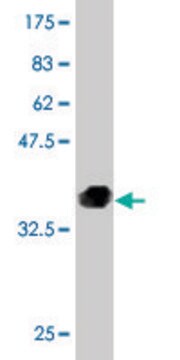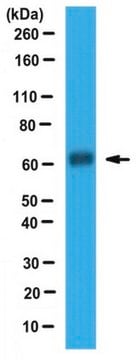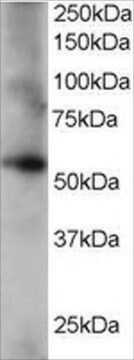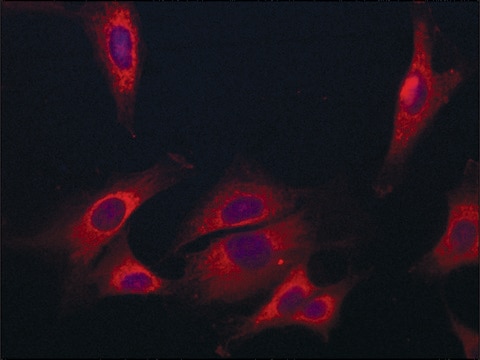ABS1605
Anti-Cytochrome p450 2J Family Antibody
serum, from rabbit
Synonim(y):
Cytochrome P450 2J, Arachidonic acid epoxygenase, CYP2J, CYPIIJ, Cytochrome P450 subfamily IIJ polypeptide, Flavoprotein-linked monooxygenase, Microsomal monooxygenase
About This Item
Polecane produkty
pochodzenie biologiczne
rabbit
Poziom jakości
forma przeciwciała
serum
rodzaj przeciwciała
primary antibodies
klon
polyclonal
reaktywność gatunkowa
human, rat, mouse
reaktywność gatunkowa (przewidywana na podstawie homologii)
porcine (based on 100% sequence homology), sheep (based on 100% sequence homology)
metody
immunohistochemistry: suitable (paraffin)
western blot: suitable
numer dostępu NCBI
numer dostępu UniProt
Warunki transportu
dry ice
docelowa modyfikacja potranslacyjna
unmodified
informacje o genach
human ... CYP2J2(1573)
Opis ogólny
Specyficzność
Immunogen
Zastosowanie
, Immunohistochemistry (Paraffin).
Western Blotting Analysis: An 1:2,000 dilution from a representative lot detected recombinant CYP2J (2J2, 2J3, 2J5, 2J8, 2J9, 2J12, 2J13), but not CYP2C (2C44, 2C50, 2C54) proteins (Courtesy of Dr. Darryl C. Zeldin, NIEHS, NIH, Research Triangle Park, NC).
Western Blotting Analysis: A representative lot detected the overexpressed human CYP2J2 in primary lung endothelial cells (ECs) from transgenic mice carrying human CYP2J2 transgene downstream of the murine Tie2 promoter to allow endothelial expression of human CYP2J2 (Deng, Y., et al. (2011). FASEB J. 25(2):703–713).
Western Blotting Analysis: A representative lot detected a 51 kDa CYP2J band in MIH-2 mouse hepatocellular carcinoma cells (HCCs), but not in C26 and MC38 mouse colon cancer cells or T3 mouse small intestine cancer cells (Homma, S., et al. (2009). Clin. Exp. Immunol. 156(2):344-352).
Western Blotting Analysis: A representative lot detected different CYP2J banding patterns between prenatal and postnatal human liver microsomal samples from human subjects ranging from 1.1 EGA (estimated gestational age) to 17-year-old of age (Gaedigk, A., et al. (2006). J. Pharmacol. Exp. Ther. 319(2): 523–532).
Western Blotting Analysis: A representative lot detected the overexpressed human CYP2J2 in heart tissues from transgenic mice carrying human CYP2J2 transgene downstream of αMHC promoter to allow cardiomyocyte-specific transgene expression (Seubert, J., et al. (2004). Circ. Res. 95(5):506-514).
Western Blotting Analysis: A representative lot detected a reduced CYP2J level in lung microsome preparations from pneumonia rats when compared with control rats (Yaghi, A., et al. (2003). Am. J. Physiol. Lung Cell Mol. Physiol. 285(5): L1099–L1105).
Western Blotting Analysis: A representative lot detected recombinant human (2J2), rat (2J3 & 2J4), and mouse (2J5, 2J6, 2J8, 2J9) CYP2J proteins (Yaghi, A., et al. (2003). Am. J. Physiol. Lung Cell Mol. Physiol. 285(5): L1099–L1105).
Immunohistochemistry Analysis: A representative lot detected the overexpressed human CYP2J2 in formalin-fixed, paraffin-embedded heart tissue sections from transgenic mice carrying human CYP2J2 transgene downstream of αMHC promoter to allow cardiomyocyte-specific transgene expression (Seubert, J., et al. (2004). Circ. Res. 95(5):506-514).
Signaling
Enzymes & Biochemistry
Jakość
Western Blotting Analysis: An 1:5,000 dilution of this antibody detected cytochrome p450 2J protein in 10 µg of rat liver tissue lysate.
Opis wartości docelowych
Postać fizyczna
Przechowywanie i stabilność
Handling Recommendations: Upon receipt and prior to removing the cap, centrifuge the vial and gently mix the solution. Aliquot into microcentrifuge tubes and store at -20°C. Avoid repeated freeze/thaw cycles, which may damage IgG and affect product performance.
Inne uwagi
Oświadczenie o zrzeczeniu się odpowiedzialności
Not finding the right product?
Try our Narzędzie selektora produktów.
Kod klasy składowania
12 - Non Combustible Liquids
Klasa zagrożenia wodnego (WGK)
WGK 1
Temperatura zapłonu (°F)
Not applicable
Temperatura zapłonu (°C)
Not applicable
Certyfikaty analizy (CoA)
Poszukaj Certyfikaty analizy (CoA), wpisując numer partii/serii produktów. Numery serii i partii można znaleźć na etykiecie produktu po słowach „seria” lub „partia”.
Masz już ten produkt?
Dokumenty związane z niedawno zakupionymi produktami zostały zamieszczone w Bibliotece dokumentów.
Nasz zespół naukowców ma doświadczenie we wszystkich obszarach badań, w tym w naukach przyrodniczych, materiałoznawstwie, syntezie chemicznej, chromatografii, analityce i wielu innych dziedzinach.
Skontaktuj się z zespołem ds. pomocy technicznej